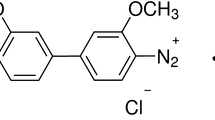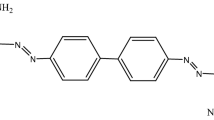Abstract
Sulphuric acid-modified bagasse has been used as low-cost adsorbent for the removal of methylene blue (MB) dye from aqueous solution. In order to remove organic compounds that contribute to chemical oxygen demand (COD), pretreatment with thorough washing of adsorbent using boiling distilled water was performed instead of conventional washing using distilled water at room temperature only. This has resulted in the highest efficiency of color removal of 99.45% and COD reduction of 99.36% for MB dye solution at pH 9. Effects of initial pH, dye concentration, adsorbent dosage, temperature, and contact time have been studied. The adsorption of MB dye was pH dependent. Langmuir and Freundlich isotherm models were tested on the adsorption data. The kinetic experimental data were analyzed using pseudo-first order, pseudo-second order, and the intraparticle diffusion model in order to examine the adsorption mechanisms. The adsorption process followed the Langmuir isotherm as well as the Freundlich isotherm and pseudo-second-order kinetic model. The process was found to be endothermic in nature.






Similar content being viewed by others
References
Afzal, M., Mahmood, F., & Saleem, M. (1992). Thermodynamics of adsorption of acetone on activated carbon supported metal adsorbent. Colloid and Polymer Science, 270, 917–929.
Ahmad, A. A., & Hameed, B. H. (2009). Reduction of COD and color of dyeing effluent from a cotton textile mill by adsorption onto bamboo-based activated carbon. Journal of Hazardous Materials, 172, 1538–1543.
APHA. (2005). Standard methods for the examination of water and wastewater (21st ed.). American Public Health Association (APHA), American Water Works Association (AWWA) and Water Environment Federation (WEF).
Behnajady, M. A., Modirshahla, N., & Ghanbary, F. (2007). A kinetic model for the decolorization of C.I. Acid Yellow 23 by Fenton process. Journal of Hazardous Materials, 148, 98–102.
Crini, G. (2006). Non-conventional low-cost adsorbents for dye removal: a review. Bioresource Technology, 97, 1061–1085.
Fan, I., Zhou, Y., Yang, W., Chem, G., & Yang, F. (2008). Electrochemical degradation of aqueous solution of Amaranth azo dye on ACF under potentiostatic model. Dyes and Pigments, 76, 440–446.
Garg, V. K., Kumar, R., & Gupta, R. (2004a). Removal of malachite green dye from aqueous solution by adsorption using agro-industry waste: a case study of Prosopis cineraria. Dyes and Pigments, 62, 1–10.
Garg, V. K., Moirangthem, A., Kumar, R., & Gupta, R. (2004b). Basic dye (methylene blue) removal from stimulated waste water by adsorption using Indian Rosewood Sawdust: timber industry waste. Dyes and Pigments, 63, 243–250.
Gong, R. M., Li, M., Yang, C., Sun, Y. Z., & Chen, J. (2005). Removal of cationic dyes from aqueous solution by adsorption on peanut hull. Journal of Hazardous Materials, 121, 247–250.
Gupta, S., & Babu, B. V. (2009). Removal of toxic metal Cr(VI) from aqueous solutions using sawdust as adsorbent: equilibrium, kinetics and regeneration studies. Chemical Engineering Journal, 150, 352–365.
Gupta, V. K., Ali, I., Suhas, & Mohan, D. (2003). Equilibrium uptake and sorption dynamics for the removal of basic dye (basic red) using low cost adsorbents. Journal of Colloid and Interface Science, 265, 257–264.
Hall, K. R., Eagleton, L. C., Acrivos, A., & Vermeulen, T. (1966). Pore and solid diffusion kinetics in fixed bed adsorption under constant pattern conditions. Industrial and Engineering Chemistry Fundamentals, 5, 212–218.
Hamdaoui, O., & Chiha, M. (2007). Removal of methylene blue from aqueous solutions by wheat bran. Acta Chimica Slovenica, 54, 407–418.
Hameed, B. H. (2009). Removal of cationic dye from aqueous solution using jackfruit peel as non-conventional low-cost adsorbent. Journal of Hazardous Materials, 162, 344–350.
Hameed, B. H., Mahmoud, D. K., & Ahmad, A. L. (2008). Sorption equilibrium and kinetics of basic dye from aqueous solution using banana stalk waste. Journal of Hazardous Materials, 158, 499–506.
Ho, Y. S., & McKay, G. (1998). Sorption of dye from aqueous solution by peat. Chemical Engineering Journal, 70, 115–124.
Jalil, A. A., Triwahyono, S., Adam, S. H., Rahim, N. D., Arif, M., Aziz, A., et al. (2010). Adsorption of methyl orange from aqueous solution onto calcined Lapindo volcanic mud. Journal of Hazardous Materials, 181, 755–762.
Karthikeyan, T., Rajgopal, S., & Miranda, L. R. (2005). Chromium (VI) adsorption from aqueous solution by Hevea Brasilinesis sawdust activated carbon. Journal of Hazardous Materials, 124, 192–199.
Kavitha, D., & Namasivayam, C. (2007). Experimental and kinetic studies on methylene blue adsorption by coir pith carbon. Bioresource Technology, 98, 14–21.
Langergren, S., & Svenska, K. (1898). About the theory of so-called adsorption of soluble substances. Vetenskapsad Handl, 24, 1–39.
Langmuir, I. (1918). The adsorption of gases on plane surfaces of glass, mica and platinum. Journal of the American Chemical Society, 40, 1361–1403.
Lata, H., Garg, V. K., & Gupta, R. K. (2007). Removal of a basic dye from aqueous solution by adsorption using Parthenium hysterophorus: an agricultural waste. Dyes and Pigments, 74, 653–658.
Li, B. X., Zhang, Z. J., Wang, J., & Xu, C. L. (2003). Chemiluminescence system for automatic determination of chemical oxygen demand using flow inhection analysis. Talanta, 61, 651–658.
Li, C. F., & Song, G. W. (2009). Photocatalytic degradation of organic pollutants and detection of chemical oxygen demand by fluorescence methods. Sensors and Actuators, 137, 432–436.
Lim, C. L., Morad, N., Teng, T. T., & Ismail, N. (2009). Treatment of Terasil Red R dye wastewater using H2O2/Pyridine/Cu(II) system. Journal of Hazardous Materials, 168, 383–389.
Malik, P. K. (2003). Use of activated carbons prepared from sawdust and rice-husk for adsorption of acid dyes: a case study of acid yellow 36. Dyes and Pigments, 56, 239–249.
Mall, I. D., Srivastava, V. C., & Agarwal, N. K. (2006). Removal of Orange-G and Methyl Violet dyes by adsorption onto bagasse fly ash—kinetic study and equilibrium isotherm analyses. Dyes and Pigments, 69, 210–223.
Mane, V. S., Mall, I. D., & Srivastava, V. C. (2007). Use of bagasse fly ash as an adsorbent for the removal of brilliant green dye from aqueous solution. Dyes and Pigments, 73, 269–278.
Manju, G. N., Raji, C., & Anirudhan, T. S. (1998). Evaluation of coconut husk carbon for the removal of arsenic from water. Water Research, 32, 3062–3070.
McKay, G., & Ho, Y. S. (1999). The sorption of lead(II) on peat. Water Research, 33, 578–584.
McKay, G., Otterburn, M. S., & Sweeney, X. (1980). The removal of color from effluents using various adsorbents: silica rate process. Water Research, 14, 15–20.
Mohammed, A., Akhtar, H. K., Shamim, A., & Ahmad, A. (1998). Role of sawdust in the removal of copper (II) from industrial wastes. Water Research, 32, 3085–3091.
Muthuraman, G., Teng, T. T., Leh, C. P., & Ismail, N. (2009). Extraction and recovery of methylene blue from industrial wastewater using benzoic acid as an extractant. Journal of Hazardous Materials, 163, 363–369.
Nainasivayam, C., & Kadirvelu, K. (1994). Coir pith, an agricultural waste by-product for the treatment of dying wastewater. Bioresource Technology, 48, 79–81.
Ofomaja, A. E. (2008). Kinetic study and sorption mechanism of methylene blue and methyl violet onto mansonia (Mansonia altissima) wood sawdust. Chemical Engineering Journal, 143, 85–95.
Robinson, T., McMullan, G., Marchant, R., & Nigam, P. (2001). Remediation of dyes on textile effluent: a critical review on current treatment technologies with a proposed alternative. Bioresource Technology, 77, 247–255.
Robinson, T., Chandran, B., & Nigam, P. (2002). Removal of dyes from a synthetic textile dye effluent by biosorption on apple pomace and wheat straw. Water Research, 36, 2824–2830.
Sayan, E. (2006). Optimization and modeling of decolorization and COD reduction of reactive dye solutions by ultrasound-assisted adsorption. Chemical Engineering Journal, 119, 175–181.
Tan, B. H., Teng, T. T., & Omar, A. K. M. (2000). Removal of dyes and industrial dye wastes by magnesium chloride. Water Research, 34, 597–601.
Tan, I. A. W., Hameed, B. H., & Ahmad, A. L. (2007). Equilibrium and kinetic studies on basic dye adsorption by oil palm fibre activated carbon. Chemical Engineering Journal, 127, 111–119.
Tan, I. A. W., Ahmad, A. L., & Hameed, B. H. (2008). Adsorption of basic dye on high-surface-area activated carbon prepared from coconut husk: equilibrium, kinetic, and thermodynamic studies. Journal of Hazardous Materials, 154, 337–346.
Wang, X. S., Zhou, Y., Jiang, Y., & Sun, C. (2008). The removal of basic dyes from aqueous solutions using agricultural by-products. Journal of Hazardous Materials, 157, 374–385.
Weber, W. J., & Morris, J. C. (1962). Advances in Water Pollution Research. Proceedings of the International Conference on Water Pollution Symposium 2. Pergamon, Oxford. pp, 231–266.
Acknowledgment
The authors acknowledge the research grant provided by Malayan Sugar Manufacturing Company under Kuok Foundation Berhad and the research facilities of Universiti Sains Malaysia (USM).
Author information
Authors and Affiliations
Corresponding author
Rights and permissions
About this article
Cite this article
Low, L.W., Teng, T.T., Ahmad, A. et al. A Novel Pretreatment Method of Lignocellulosic Material as Adsorbent and Kinetic Study of Dye Waste Adsorption. Water Air Soil Pollut 218, 293–306 (2011). https://doi.org/10.1007/s11270-010-0642-3
Received:
Accepted:
Published:
Issue Date:
DOI: https://doi.org/10.1007/s11270-010-0642-3




